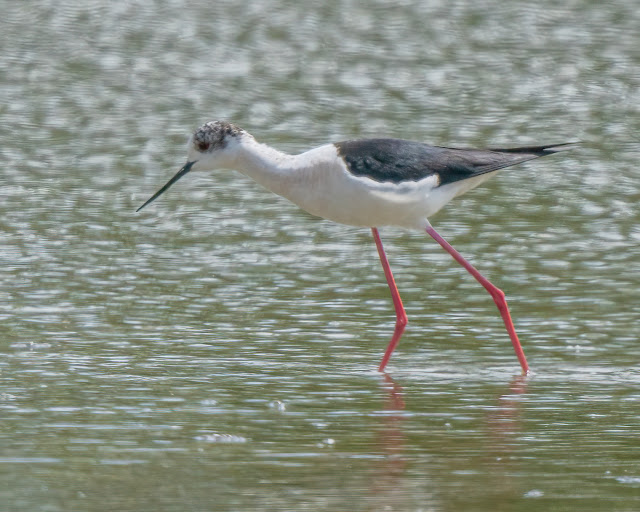 |
| Black-winged Stilt |
Carrying on with last weeks theme, pseudo-local birding was the name of the game again this week. Doubly so as my normal bird-mobile is in the garage and the curtesy car is best described as a biscuit tin on wheels which I wouldn’t really fancy driving any distance. It does, however, have the advantage that it seems to use no fuel whatsoever.
Slimbridge was my chosen destination yesterday, a far cry from the peace and tranquillity of last weeks Wyre forest but, when the crowds of children start to annoy me, I remind myself that if we don’t educate this generation about nature and our delicate planet much better than ours there really is no hope. Our relentless pursuit for higher and higher yields of chemically produced food and the resulting decimation of our insect population worries me immensely. We are probably already too late to reverse the decline in our ecosystem. I wonder how my grandchildren will look back on my generation, not with any respect I suspect.
Anyway back to Slimbridge. There were two scarce birds present, namely Garganey and Black-winged Stilt. I have seen both many times but I fancied a chilled out day photographing them.
Members are allowed into Slimbridge an hour or so early but are normally limited to the hides along the Rushy side of the reserve. The Garganey were reported as being on the Rushy and the Stilt on the south lake on the other side of the reserve. Normally when a rare bird is present members are given access early to the other hides but on this occasion we weren’t. Slightly odd as the last time Black-wing Stilt were present, also on the south lake a few years back, we were allowed early access.
Anyway no real problem as I could spend the first hour with the three drake Garganey. They were comparatively close to the hide but absolutely fast asleep with their heads tucked in occasionally opening a wary eye to check for threats. At this time of year they would have already had four hours of daylight to feed and were quite content to snooze in the sun.
Come 09:30 I made my way with a small number of other birders to the South lake where the Black-winged Stilt was showing somewhat distantly in the middle of the lake. I spent most of the morning at the south lake taking somewhat unsatisfactory distant photographs of the Stilt. While it was occasionally harassed into flight by zealous parent Avocets, it always gravitated back to roughly the same distant position. I popped back to the Rushy hide before lunch to check on the Garganey but they were still fast asleep. After a quick bite to eat I made my way back to the Stilt and after a while it relocated much closer allowing some better photographic opportunities.
The Black-winged Stilt is one of a small minority of birds that seem to be benefiting from climate change. The migrant summer population is slowly spreading north resulting in UK records increasing noticeably over the past few years. They have also successfully raised young here. It is a very cosmopolitan species which is now normally split into four distinct species. The Europe, Asia and Africa species is the nominate Himantopus Himantopus. The Black-necked Stilt H. mexicanus, and White-backed Stilt H. melanurus, both inhabit the Americas. Finally the Pied Stilt, H. leucocephalus which I have seen, hails from southeast Asia to Australia and New Zealand.
 |
| Pied Stilt - New Zealand |
Truth be told it is a rather odd ungainly looking bird with long thin pink legs that look ridiculously delicate and a pencil thin long bill that allow it to feed in deeper water than most other waders.
After taking too many basically identical pictures of the Stilt I made my way back to the Rushy hide where the Garganey were finally waking up. They are our only migratory duck spending the winter in southern Africa and India. They are rare schedule 1 breeding birds in the UK and most of the birds we see being on migration stop over to their breeding grounds further north. The adult male is unmistakable, with its brown head and breast with a broad white crescent over the eye. The rest of the plumage is grey, with loose grey scapular feathers It has a grey bill and legs. In flight, it shows a pale blue speculum with a white border.
Simple images of ducks on water, dare I say it, can be rather dull so I was hoping that one of the drakes would make its way over to a green patch near the shore to give the picture a bit more interest. Luckily one did for a few moments allowing me to capture the picture I hoped for.
 |
| Garganey |
 |
| Avocet |
I spent the last hour of the day on a fools errand looking for the worlds most elusive Bluethroat at the end of the summer walkway. The sun was out and my first marsh orchid of the year was in flower along the walkway so not a completely wasted way to end a very chilled out and pleasant late spring day.
Footnote – my blogs are posted with sometimes rather imaginative spelling and grammar due to my extreme dyslexia!




Comments
Post a Comment